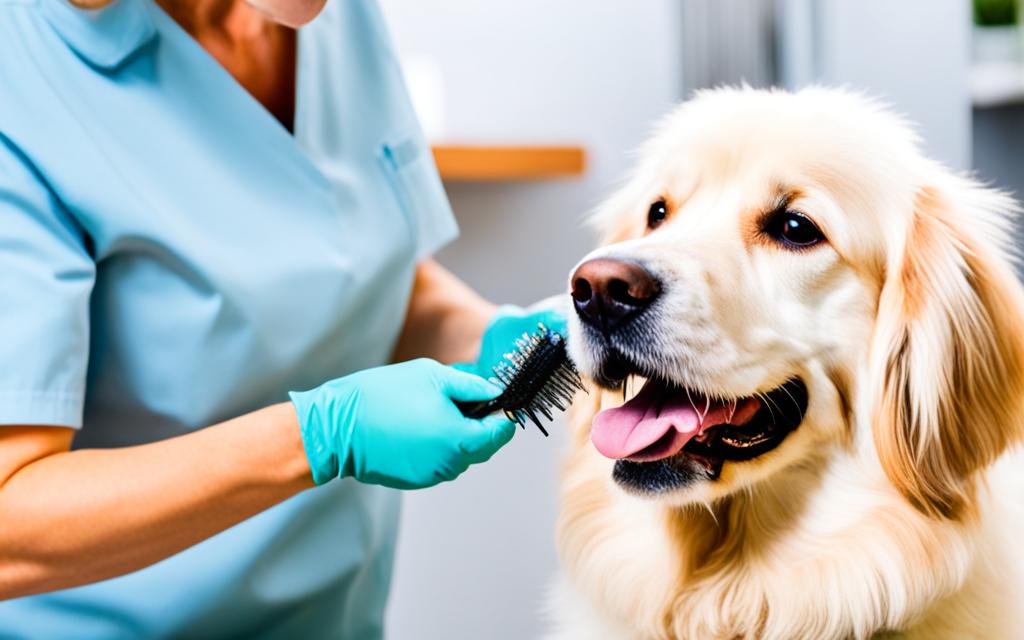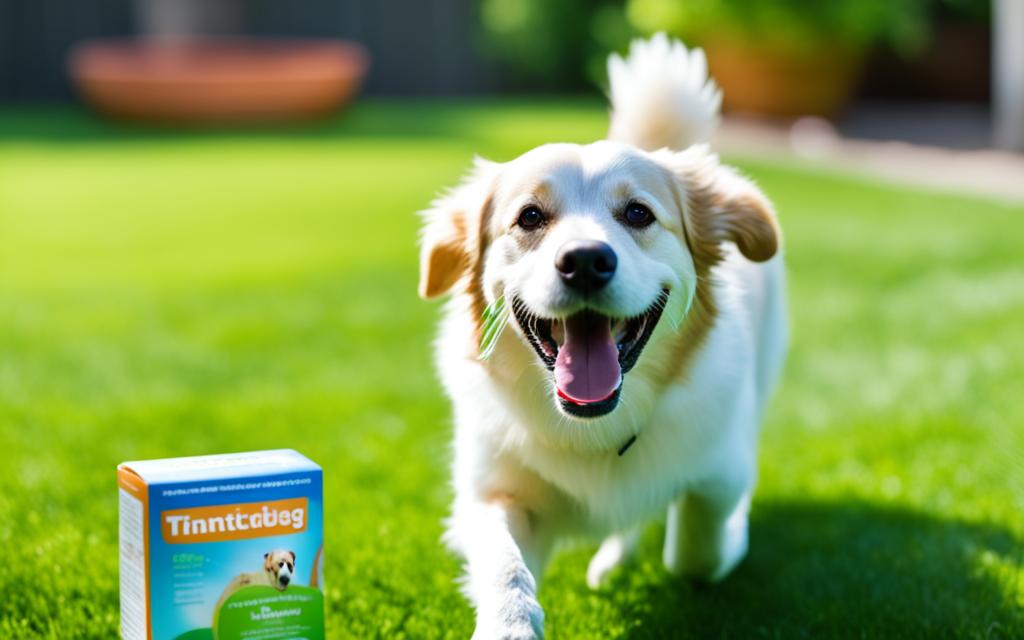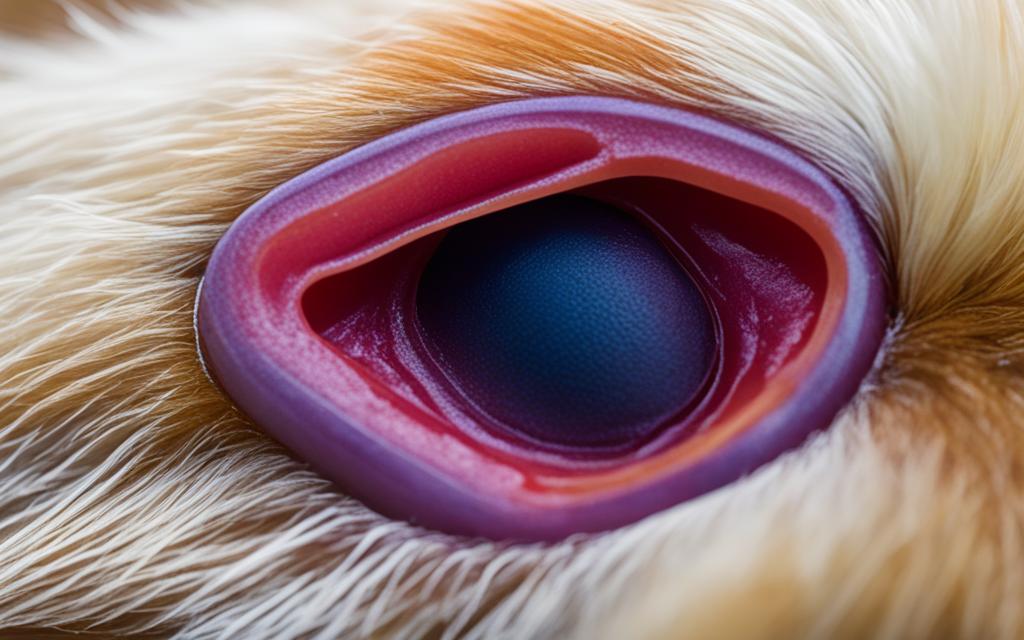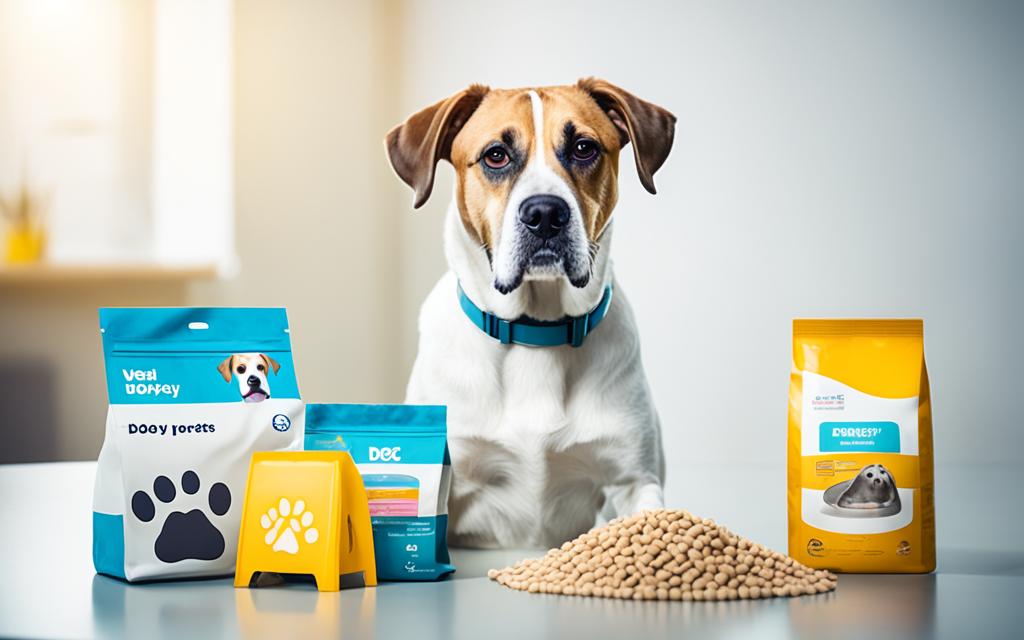Keeping your dog free from parasites is key to their health and happiness. Effective parasite control keeps your furry friend comfy and safe. It also lowers the risk of serious health problems. Dogs face threats from inside and outside, like worms and fleas. Knowing about these parasites is important for keeping your dog safe.
Using a mix of steps can greatly improve your dog’s health. This lets them live a happy, healthy life as your best friend.
Understanding Dog Parasites
Dog owners must know about the different parasites that can harm their pets. These can be inside or outside the body. Knowing about them helps owners keep their dogs healthy and happy.
Common Types of Dog Parasites
Many parasites can affect dogs, including:
- Fleas: These tiny insects drink a dog’s blood, causing discomfort and sometimes serious health problems.
- Ticks: These arachnids attach to a dog’s skin and can spread serious infections like Lyme disease.
- Heartworms: These internal parasites come from mosquito bites and can cause heart and lung problems.
- Roundworms: Living in a dog’s gut, they cause vomiting, diarrhea, and can lead to malnutrition.
- Tapeworms: Caused by eating infected fleas, they result in weight loss and irritation.
How Parasites Affect Your Dog’s Health
Parasites can greatly affect a dog’s health. Their effects range from mild itching to severe conditions like anemia and organ damage. Knowing how parasites affect dogs helps with early treatment and prevention.
Parasites can lead to health issues in dogs, making it easier for infections or other problems to develop. Some can even spread diseases to humans. This shows why it’s crucial to prevent parasites for both pets and their owners.
Signs That Your Dog May Have Parasites
It’s key to know the signs of parasites in your dog for their health. Changes in behavior can show an infestation. Catching these signs early means better treatment chances and less risk of serious health problems. Watching your pet closely can help spot these early signs.
Behavioral Changes to Watch For
Watching your dog’s behavior is crucial. Look for these signs that could mean parasites are present:
- Increased scratching or biting at the skin.
- Lethargy or reduced activity levels.
- Changes in eating habits, such as reduced appetite or increased hunger.
- Irritability or signs of discomfort.
Physical Symptoms of Infestation
Physical signs can clearly show if your dog has parasites. Knowing what to look for helps in observing pet health:
| Symptom | What It Indicates |
|---|---|
| Weight Loss | Possible intestinal parasites draining nutrients. |
| Bloated Abdomen | Possible presence of worms or other parasites. |
| Visible Worms in Feces | Direct evidence of a parasitic infestation. |
| Skin Irritations | Can indicate fleas, ticks, or other external parasites. |
Best Practices for Dog Parasite Prevention
Keeping your dog safe from harmful parasites needs a detailed plan. Regular vet visits are key to your dog’s health and stopping infestations. Here are some key steps for effective parasite prevention.
Regular Vet Check-Ups
It’s important to schedule regular check-ups for early health issues detection. Vets check your dog’s overall health and test for parasites during these visits. They often do blood tests for heartworms and other parasites, tackling threats early. Regular vet visits keep your dog healthy and give you peace of mind.
Vaccinations and Medication
Getting the right vaccinations is crucial for your dog’s health. Vaccines against fleas, ticks, and heartworms are key to prevention. Following your vet’s advice on medication helps a lot in preventing parasites. Regular vet visits make sure your dog gets the right shots and meds, helping their health over time.
Maintaining a Clean Environment
Keeping your dog’s living area clean is vital for parasite prevention. Clean their bedding, yard, and living spaces often to reduce flea and tick risks. Good grooming also helps keep your dog clean, making it hard for parasites to survive. These habits help your dog’s health and make your home more comfortable.

| Practice | Importance | Frequency |
|---|---|---|
| Regular Vet Check-Ups | Early detection and treatment of health issues | At least once a year |
| Vaccinations | Prevention of common parasites | As recommended by a vet |
| Clean Environment | Reduces parasite risk | Weekly cleaning |
Nutrition and Parasite Resistance
Feeding your dog right is key to boosting their immune system against parasites. A balanced diet helps make their immune system strong. This makes them less likely to get infested. Knowing how to pick the best food and following a diet that fights parasites can greatly improve your dog’s health.
Choosing the Right Dog Food
Choosing top-notch dog food is crucial for a strong immune system. Look for food that has:
- High-quality proteins from sources such as chicken, fish, or lamb
- Whole grains like brown rice or oats
- Fruits and vegetables that provide essential vitamins and minerals
These ingredients help with dog nutrition and fight parasites. Talking to your vet about what to feed your pet can also help a lot.
Supplements that Boost Immunity
Along with good food, some supplements can really help your dog’s immune system. Think about adding:
- Omega-3 fatty acids to reduce inflammation and improve skin health
- Probiotics to support gut health and boost immune function
- Vitamins, like Vitamin C and E, that help strengthen immunity
Adding these supplements to your dog’s daily routine can help them fight parasites better. This keeps them strong against infestations.
Safe Pest Control Methods for Dogs
Keeping your dog free from fleas and ticks is important. Many pet owners like natural ways to keep their pets safe from harmful chemicals. There are many pet-safe pest remedies that can help. This section looks at both natural and commercial products.
Natural Remedies for Fleas and Ticks
There are several natural remedies that work well against fleas and ticks. Here are some good options:
- Essential Oils: Oils like lavender, peppermint, and cedarwood can keep pests away and smell nice. Just mix them with a carrier oil before putting it on your dog.
- Diatomaceous Earth: This powder dries out fleas and ticks, making it a great natural way to control them. Just sprinkle it where your pets hang out.
- Homemade Sprays: Making a spray with water and vinegar or witch hazel is safe for your dog. Use it on their fur and where they sleep to keep pests away.
Recommended Commercial Products
If you prefer commercial products, there are many good ones out there. Here are some top choices:
| Product Type | Product Name | Features |
|---|---|---|
| Topical Treatment | Frontline Plus | Needs to be applied once a month, kills fleas and ticks, stays waterproof. |
| Collar | Seresto Collar | Lasts up to 8 months, slowly releases active ingredients, safe for pets. |
| Oral Medication | Bravecto | One dose lasts 12 weeks, fights fleas and ticks. |
Choosing the right pest control for your dog depends on your situation and your pet’s needs. Going for pet-safe options is key to keeping your dog healthy and pest-free.
Grooming Techniques to Prevent Parasites
Proper dog grooming is key to keeping your dog healthy and clean. Regular grooming keeps your dog looking great and helps prevent parasites. It’s a chance to use the right bathing techniques.
Bathing Your Dog Properly
Bathing your dog is a must for removing dirt, loose fur, and parasites. Here are some tips for effective bathing:
- Choose a dog-specific shampoo to avoid skin irritation.
- Wet your dog’s coat well before applying shampoo for even coverage.
- Massage shampoo into the coat, focusing on areas prone to dirt and parasites.
- Rinse thoroughly to remove all soap residues, which can cause skin problems.
- Dry your dog with a towel or a dog-safe blow dryer to prevent chilling.

Regular baths and brushing help spot parasites early. Keeping your dog groomed is a great way to prevent parasites.
Outdoor Safety Tips
Keeping your dog safe outside means knowing what’s around you. Dogs can pick up parasites in certain places, like tall grass or areas where wildlife hangs out. Here are some ways to keep your dog safe while having fun outside.
Avoiding High-Risk Areas
Picking the right spot for walks is key. Stay away from places known for parasites to lower the risk of infestations. Here are some tips:
- Stick to paved paths or well-maintained trails.
- Avoid areas where other animals frequently congregate.
- Keep your dog away from tall grass and dense vegetation.
Using Preventative Treatments During Walks
Using preventive steps during walks helps keep your dog safe. You can use sprays, collars, or topical treatments. Here are some good options:
- Topical treatments: Always apply as your vet suggests.
- Flea and tick collars: Make sure they fit well.
- Insect repellent sprays: Choose ones safe for pets.
These steps not only keep your dog safe but also make them healthier and happier. Spend time picking the right methods for a parasite-free outdoor time.
| Preventative Method | Effectiveness | Application Frequency |
|---|---|---|
| Topical Treatments | High | Monthly |
| Flea and Tick Collars | Medium | Every 6-8 months |
| Insect Repellent Sprays | Medium | Before each walk |
Traveling with Dogs: Keeping Them Parasite-Free
When you take your dogs on a trip, keeping them safe from parasites is key. Getting ready before you go can make a big difference. It helps prevent infestations and keeps your pets healthy.
Precautions for Road Trips
Before you hit the road, think about these steps:
- Check your dog’s health. Make sure their shots and parasite prevention are current.
- Have a pet travel kit ready with meds, food, water, and grooming tools.
- Look for ticks or fleas on your dog often, especially after they’ve been outside.
- Clean up after your pet in new places to stop parasites from spreading.
- Talk to your vet about extra steps you should take in certain areas.
Destinations to Consider
Picking safe places to visit can make your trip better and lower the risk of parasites. Here are some spots that are good for pets and have fewer parasites:
| Location | Parasite Risk Level | Pet-Friendly Activities |
|---|---|---|
| National Parks | Low | Hiking, camping |
| Beach Resorts | Medium | Playing in the sand, swimming |
| Rural Areas | Low | Exploring nature trails |
| Pet-Friendly Cities | Medium | Dog parks, outdoor cafes |
Conclusion
Keeping your dog safe from parasites is key to a long, healthy life for them. This article shared important tips on how to do this. It talked about the need for regular vet visits, good food, and safe grooming.
By following these steps, you make your dog healthier and lower the risk of parasites. It’s all about taking care of your dog in every way possible.
One main point is that being proactive is very important for your dog’s health. This means making sure they get the right shots and meds. It also means keeping their living area clean and being careful when they go outside.
Each step you take helps keep your dog safe from pests. It’s all about making your dog’s life better and keeping them healthy.
Putting effort into parasite prevention shows you care about your dog’s happiness and health. By being informed and taking action, you give your dog the best chance to live a happy life without parasites.




